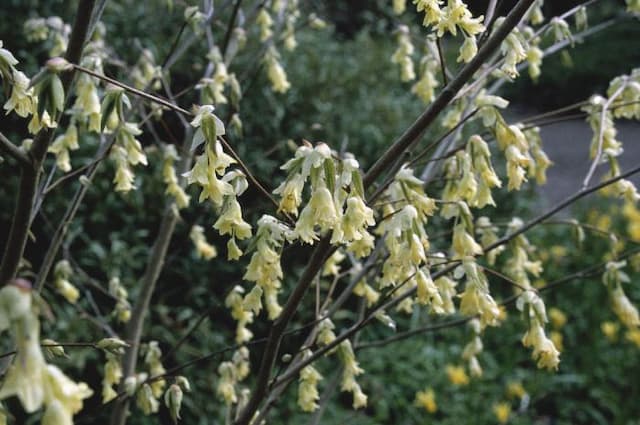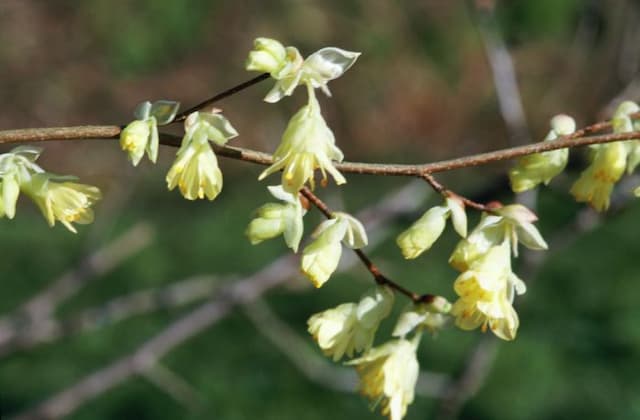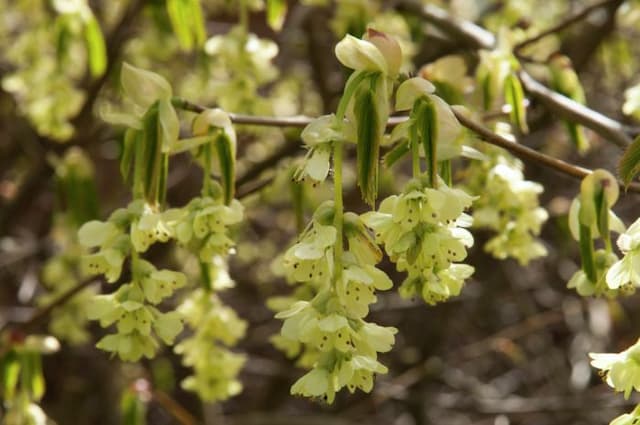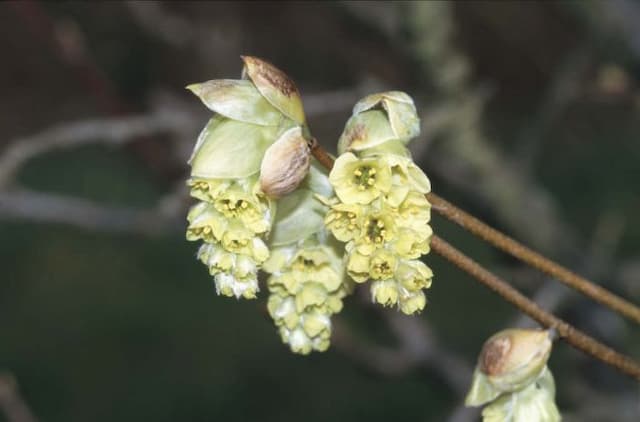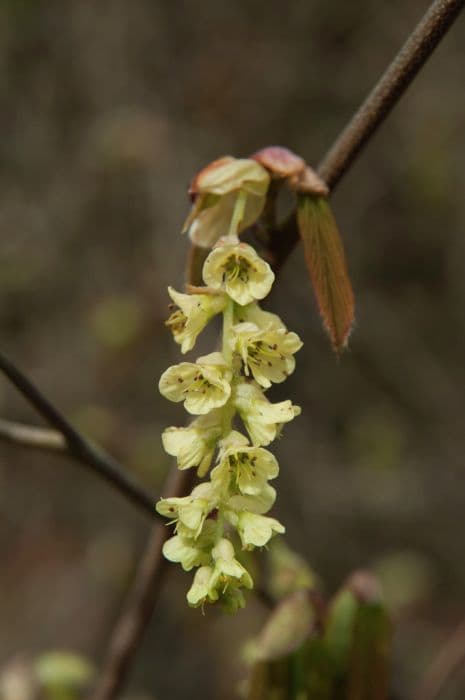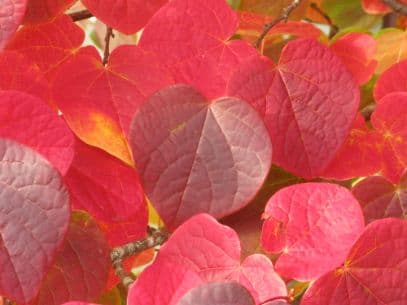Witch hazel Hamamelis × intermedia 'Old Copper'

ABOUT
The plant known as Witch Hazel 'Old Copper' is recognized for its unique and attractive appearance. It is a deciduous shrub that showcases characteristics particularly captivating during the colder months when many other plants have lost their foliage. One of the most striking features of Witch Hazel 'Old Copper' is its flowers. The blooms appear in the late winter to early spring, delivering a splash of color when the garden is often at its most dormant. The petals of the flowers are narrow, ribbon-like and crinkled, with a warm, coppery orange hue that seems to sparkle against the bare branches. The leaves of the Witch Hazel 'Old Copper' are also noteworthy. During the growing season, its foliage presents a broad, oval shape, starting out with green coloration. As the seasons change, the leaves transition to take on an eye-catching array of autumnal colors, from yellow to orange and red, before they finally drop, leaving the twisted, picturesque branches to stand alone through the winter. The overall aesthetic of 'Old Copper' is enhanced by its naturally spreading form that can create a rounded and slightly irregular silhouette, giving a sense of movement and natural beauty to the landscape.
About this plant
 Names
NamesSynonyms
Witch Hazel, Hybrid Witch Hazel
Common names
Hamamelis × intermedia 'Old Copper'.
 Toxicity
ToxicityTo humans
Witch hazel generally is not considered toxic to humans. However, ingesting large quantities of any plant material can potentially cause gastrointestinal discomfort, nausea, vomiting, or diarrhea due to the presence of tannins and other plant compounds. It's always best to exercise caution and not consume parts of ornamental plants not meant for consumption.
To pets
Witch hazel is not widely recognized as toxic to pets, but it is advisable to prevent pets from ingesting the plant. As with humans, consuming plant material can lead to gastrointestinal upset in animals. If a pet does ingest a significant amount of witch hazel, it's recommended to observe for any signs of distress and consult a veterinarian if any concerning symptoms arise.
 Characteristics
CharacteristicsLife cycle
Perennials
Foliage type
Deciduous
Color of leaves
Green
Flower color
Copper
Height
12 feet (3.66 meters)
Spread
12 feet (3.66 meters)
Plant type
Shrub
Hardiness zones
5
Native area
Cultivar
Benefits
 General Benefits
General Benefits- Ornamental Value: Provides vibrant copper to orange-red fall foliage and fragrant yellow flowers that bloom in late winter to early spring, offering year-round visual interest.
- Landscape Versatility: Can be used in a variety of landscape settings, including as a specimen plant, in mixed borders, or in woodland gardens.
- Wildlife Attraction: The flowers provide nectar for pollinators such as bees in the late winter when few other plants are in bloom.
- Low Maintenance: Typically requires minimal care once established, with little need for fertilization or pruning.
- Drought Tolerance: Once established, it has moderate tolerance to drought conditions, reducing the need for regular watering.
- Cold Hardy: Resilient in a range of climates and can handle cold temperatures, making it suitable for gardens in cooler regions.
- Tolerance of Different Soil Types: Adapts to a variety of soil conditions, though it prefers well-drained, fertile loam.
 Medical Properties
Medical PropertiesThis plant is not used for medical purposes.
 Air-purifying Qualities
Air-purifying QualitiesThis plant is not specifically known for air purifying qualities.
 Other Uses
Other Uses- Photography Prop: The Witch Hazel 'Old Copper' with its unique foliage and flowers can serve as an attractive backdrop for outdoor photography.
- Artistic Inspiration: Artists may use the distinctive look of Witch Hazel 'Old Copper' as a subject or inspiration for paintings, illustrations, and other art forms.
- Dye Production: The leaves and bark of Witch Hazel can potentially be used to create natural dyes for textiles, though 'Old Copper' is not specifically known for this use.
- Natural Mulch: The leaves of Witch Hazel 'Old Copper' can be composted and used as mulch to enrich soil in gardens.
- Education and Research: This plant can be used in botanical studies to teach students about hybrid plants and their characteristics.
- Craft Material: Dried branches and seed capsules could be used in creating rustic crafts and home decor.
- Scented Arrangements: While not commonly known for its scent, Witch Hazel 'Old Copper' could be experimented with in potpourris or scent sachets.
- Winter Interest: As a plant that blooms in late winter, Witch Hazel 'Old Copper' can provide visual interest in gardens during the colder months.
- Privacy Screening: When planted in groups, Witch Hazel 'Old Copper' can act as a natural privacy screen due to its size and foliage.
- Seasonal Celebrations: The branches of Witch Hazel 'Old Copper' might be included in decorative displays for seasonal festivals, particularly autumn events to highlight its coppery tones.
Interesting Facts
 Feng Shui
Feng ShuiThe Witch Hazel is not used in Feng Shui practice.
 Zodiac Sign Compitability
Zodiac Sign CompitabilityThe Witch Hazel is not used in astrology practice.
 Plant Symbolism
Plant Symbolism- Healing and Protection: As a member of the Witch Hazel family, Hamamelis x intermedia 'Old Copper', commonly known as Witch Hazel, is often associated with healing properties. It has been used medicinally for centuries to soothe skin irritations and wounds.
- Charm and Attraction: Witch Hazel's unique, fragrant winter flowers give it a symbolic connection to enchantment and the power to attract good influences.
- Uniqueness: With its distinctive copper-colored flowers that bloom in the late winter, Witch Hazel symbolizes the uniqueness and the celebration of individuality.
- Resilience: Blooming in the winter, Witch Hazel represents resilience and the ability to endure and flourish in adversity.
- Nature’s Awakening: As it is one of the first plants to flower in the year, often while snow is still on the ground, Witch Hazel symbolizes the awakening of nature and the early signs of spring.
 Water
WaterThe Witch Hazel 'Old Copper' should be watered deeply when the top inch of soil feels dry to the touch, which typically means weekly during active growth in the spring and summer, and less frequently during the dormant fall and winter months. It's best to water with about 1 to 1.5 gallons per watering session, depending on the size of the plant and the weather conditions. Ensure that the water penetrates deeply into the soil to encourage a strong root system, but avoid waterlogging as this can lead to root rot.
 Light
LightWitch Hazel 'Old Copper' thrives in full sun to partial shade. It's best situated in a location where it can receive at least 4 to 6 hours of direct sunlight daily, with some afternoon shade in hotter climates to protect it from intense heat. An eastern or western exposure that provides sunlight with some protection during the peak intensity hours is ideal for promoting vibrant bloom and healthy growth.
 Temperature
TemperatureWitch Hazel 'Old Copper' is a hardy plant that can tolerate a wide range of temperatures, typically from 20 to 90 degrees Fahrenheit. It does best in a temperate climate and can survive brief periods of colder winter temperatures down to about 10 degrees Fahrenheit. The ideal temperature range for optimal growth and flowering is between 40 and 75 degrees Fahrenheit.
 Pruning
PruningPrune Witch Hazel 'Old Copper' annually in late winter or early spring before new growth begins. This maintains the plant's shape and encourages the growth of vibrant new branches that will produce flowers. Remove any dead or crossed branches and trim back to shape the plant as desired, being careful not to over-prune as this can reduce flowering.
 Cleaning
CleaningAs needed
 Soil
SoilWitch Hazel 'Old Copper' thrives in a well-draining soil mix with high organic content; peat or leaf mold mixed with loamy soil can work well. The ideal pH for this witch hazel cultivar is slightly acidic to neutral, ranging from 5.5 to 7.
 Repotting
RepottingWitch Hazel 'Old Copper' is typically grown as a garden shrub and does not commonly require repotting. If grown in containers, repot every 3-5 years, in spring before new growth starts.
 Humidity & Misting
Humidity & MistingWitch Hazel 'Old Copper' prefers average outdoor humidity levels. It is quite adaptable and does not require specific humidity conditions when planted in the landscape.
 Suitable locations
Suitable locationsIndoor
Provide bright light, cool temps, and regular watering.
Outdoor
Plant in sun to part shade, mulch well, and water regularly.
Hardiness zone
5-8 USDA
 Life cycle
Life cycleWitch Hazel 'Old Copper' begins its life cycle with seed germination, which occurs in spring after a period of cold stratification. Upon germination, the seedling emerges and develops into a young plant with characteristic broad leaves. Over the years, the plant grows into a large shrub, producing its distinct copper-colored foliage in the growing season. In late winter to early spring, before the foliage emerges, it produces fragrant flowers with ribbon-like petals in a rusty orange to coppery-red color. After pollination, typically by insects drawn to the flowers during the sparse winter months, the plant sets seed that matures throughout the summer. This shrub reaches maturity and can reproduce for many years while also able to spread vegetatively through suckering, creating a clumped growth habit.
 Propogation
PropogationPropogation time
Late winter to early spring
The most popular method of propagation for the Witch Hazel 'Old Copper' is through softwood cuttings. This is typically done in late spring or early summer when new growth is still tender. To propagate, a gardener should cut a piece of the stem that is 4-6 inches long, making sure it has several leaves. The lower leaves are removed, and the cut end is dipped in rooting hormone before being placed in a mixture of peat and perlite or a well-draining potting mix. The cutting should then be kept under high humidity conditions, either in a misting system or by covering with a plastic bag, and placed in indirect sunlight. Rooting usually occurs within 4 to 6 weeks. Once roots have developed, the cutting can be transplanted into its own pot with standard potting soil.
